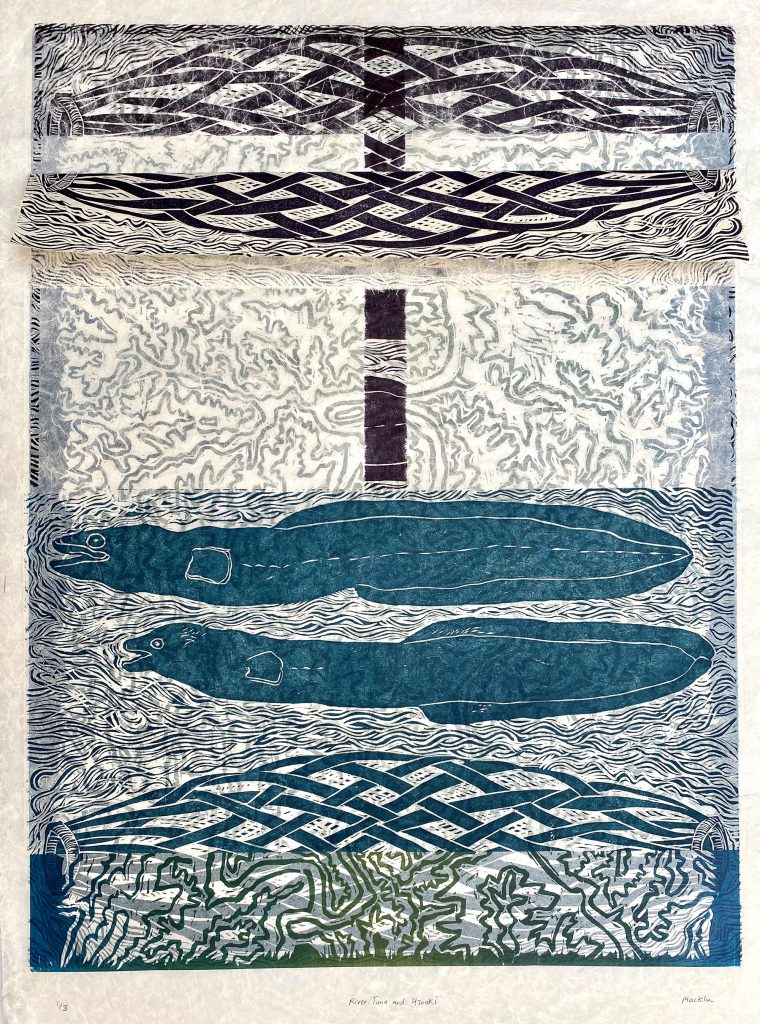Abstract
One of the most enduring and culturally vibrant potamic societies in the world are the Māori peoples of Aotearoa/New Zealand. The creation of the prints featured in this article have emerged from a long-term and ongoing trans-disciplinary art-science project – Te Awa Rio/the River’s voicen– that has for the first time brought together river scientists, visual artists and the Te Atihaunui- a-Paparangi people or iwi (kin groups) of the Whanganui River of the North Island. Offered, with much humility, these works show how indigenous knowledge, an understanding of deep time human- environment entanglements, and a reconnection with the watery realm, can offer society a way to rethink how best to navigate through and beyond our current planetary crisis.
Planetary wellbeing, in the past as well as in the present era of anthropogenic climate weirding, pandemics and environmental breakdown, has often been measured by the health of our rivers and by the partnerships, formal or informal, that communities make with them and the watery realm more generally (Macklin and Lewin, 2020). Water is the lifeblood of humankind, and without water to support vital biological and social functions, people cannot flourish. The early ‘hydraulic’ civilisations of Mesopotamia, the Huang He (Yellow River), Indus and Nile Valleys understood this very well (Macklin and Lewin, 2015) and the fate of these societies was intimately entwined with their stewardship of water resources and their resilience from the impacts of exceptional floods and droughts.
References
Charpleix, L. (2018) The Whanganui River as Te Awa Tupua: Place based law in a legally pluralistic society. The Geographical Journal, 184(1), pp.19-30.
Fuller, I.C., Macklin, M.G., Toonen, W.H., Turner, J. and Norton, K. (2019) A 2000 year record of palaeofloods in a volcanically-reset catchment: Whanganui River, New Zealand. Global and Planetary Change, 181, p.102981.
Macklin, J.M. (2014) The Watery Realm: rapprochement of art and science. Artist’s Book. ISBN 978-1-927196-01-4.
Macklin, M.G. and Lewin, J. (2015) The rivers of Civilisation. Quaternary Science Reviews, 114, pp.228-244.
Macklin, M.G. and Lewin, J. (2020) The Rivers of Humankind. In Science, Faith and the Climate Crisis. Emerald Publishing Limited.
Macklin, J.E. and Macklin, M.G. (2011) Rivers – lines of time. In S. Mills (Ed.), Interventions: Măgura past and present (pp. 59–72). Bucureşti: Renaissance. Retrieved from http://orca.cf.ac.uk/id/eprint/28994
Macklin, J.E. and Macklin, M.G. (2019) Art-geoscience encounters and entanglements in the watery realm. Journal of Maps, 15(3), pp.9-18.
Of Foresters, Farmers and Fish – Tales from the Wildwoods of the Old and New World (2020) Exhibition National Botanic Garden of Wales. Available from: https://botanicgarden.wales/visit/whats-on/event/ exhibition-of-foresters-and-fish-tales-from-the-wildwoods-of-the-old- and-new-world/ [Accessed 20 November 2020].
Rivers of Gold (2020) Art-Science Collaboration.Available from:https:// rivers-of-gold.com/art-science-collaboration/ [Accessed 20 November 2020].
Salmond, A. (2014) Tears of Rangi: Water, power, and people in New Zealand. HAU: Journal of Ethnographic Theory, 4(3), pp.285-309. Te Awa Rio (2020) Exhibition Sarjeant Gallery Te Whare o Rehua Whanganui. Available from:https://www.sarjeant.org.nz/gallery/te-awa-reo/ [Accessed 20 November 2020].

This work is licensed under a Creative Commons Attribution 4.0 International License.
Copyright (c) 2021 Judy E. Macklin, Mark G. Macklin
